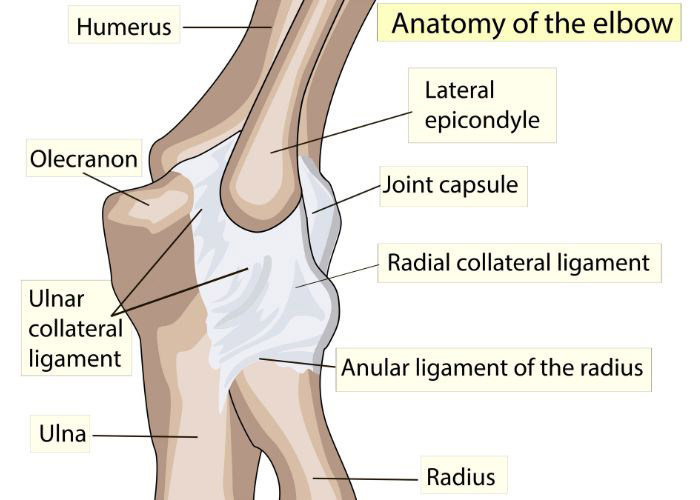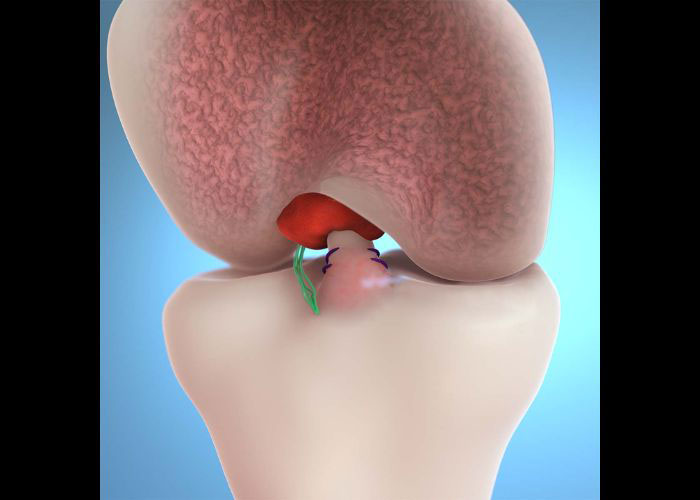What is the elbow joint?
The elbow is an upper extremity joint that connects the forearm to the upper arm in a hinge-like configuration. Although assembled in a relatively simple anatomical arrangement, the elbow joint can withstand a significant amount of force while also disguising an impressive range of motion. Dr. Ronak Mukesh Patel, orthopedic elbow specialist serving patients in Sugar Land, Pearland, and the Houston, Texas area, has the knowledge and understanding of elbow anatomy, as well as substantial training and experience in treating common elbow injuries.

What are the three joints of the elbow?
The elbow is commonly associated with a singular structure; however, the anatomical arrangement of the elbow is formed by three separate bones that are blanketed in the same joint capsule. These form three joints formed by the ends the bones and connected with anchoring tendons and ligaments.
Radiohumeral Joint:
- The head of the radius (smaller forearm bone on the thumb side) connects to the capitellum of the humerus (upper arm bone) to form this ball-and-socket joint. The surrounding ligaments prevent the separation of these bones.
Ulnohumeral Joint:
- The trochlear notch of the ulna (larger forearm bone on the pinky finger side) forms a hinge joint with the trochlea of the humerus (upper arm bone). This joint provides flexion and extension only.
Proximal Radioulnar Joint:
- The head of the radius (thumb side forearm bone) articulates with the radial notch of the ulna (pinky side forearm bone) to form a synovial pivot joint. This joint allows rotation of the hand to face the palm up (pronation) or down (supination).
What are other important structures of the elbow joint?
The cartilage, ligaments, muscles, and nerves must work collectively to facilitate movement of the elbow joint while providing stability.
Articular Cartilage:
- The connecting ends of the humerus, radius, and ulna are covered in a slippery and shiny white tissue known as articular cartilage. This layer of connective tissue protects the articulating surfaces of the bones while also allowing these bones to painlessly glide over one another during joint movement.
Synovial Membrane:
- The elbow joint has an extensive synovial lining. This thin tissue secretes a viscous fluid that reduces friction between the bony ends allowing for easier and painless joint movement.
Muscles:
There are numerous muscles that enable the elbow joint to perform throwing and lifting movements.
Flexors:
- The brachialis muscle acts strictly as an elbow flexor that originates from the anterior humerus and is anchored at two separate points on the ulna. The brachioradialis muscle emanates from the distal humerus as a forearm muscle and inserts near the wrist. The biceps brachii muscle travels along the upper arm and attaches to the radial tuberosity.
Extensors:
- The triceps brachii muscle, another upper arm muscle, anchors to the olecranon process of the ulna and enables extension of the forearm.
Ligaments:
There are elastic bands of tissue (ligaments) within the elbow joint that form a dense and fibrous network of connective tissues surrounding the elbow joint capsule. These ligaments function similarly to strong ropes to connect bones and maintain bone alignment.
Medial Ulnar Collateral Ligament:
- This triangular-shaped ligament band is located along the medial portion of the elbow joint connecting the distal humerus to the proximal ulna. This ligament’s primary responsibility is joint stabilization. This is what is often injured in throwing athletes and is referred to as the Tommy John ligament. This is the
Lateral Ulnar Collateral Ligament:
- This ligament band emanates from the lateral epicondyle of the humerus and inserts on the supinator crest of the ulna. It is responsible for providing joint stability against medial to lateral stress on the elbow. This is the primary stabilizer of the lateral (outside) elbow and is torn in an elbow dislocation.
Annular Ligament:
- This ligament encircles the radial head and maintains contact with the radial notch of the ulna. Its primary role is to maintain stability of the radial head and neck.
Tendons:
A tendon is a tough band of fibrous connective tissue that absorbs the force of a muscle contraction to provide bone movement. Within the elbow joint are four main tendons that connect muscle to bone for joint stabilization. The distal biceps tendon connects the biceps muscle to the radial tuberosity. The distal triceps tendon connects the triceps muscle to the olecranon process of the ulna. The common extensor tendon anchors the superficial extensor muscles of the forearm to the lateral epicondyle of the humerus. The common flexor tendon, also called the flexor pronator tendon, anchors the superficial flexor and pronator muscles of the forearm to the medial epicondyle of the humerus.
Blood Supply:
The elbow joint is saturated with an arterial blood supply derived from the cubital anastomosis including the collateral and terminal branches of the brachial and deep brachial arteries. The blood is then returned by the ulnar, radial, and brachial veins.
Nerves:
The median, musculocutaneous, and radial nerves innervate the elbow joint anteriorly while the ulnar nerve posteriorly innervates the elbow joint. These nerves disseminate important sensory information, such as touch, pain, and temperature, back to the brain.
What are common elbow injuries?
Even though the elbow joint has an impeccable ability to withstand large forces without sacrificing stability, the intricate arrangement of these structures can still experience injury and damage. The common elbow injuries treated by Dr. Patel are, as follows:
- Elbow Arthritis
- Elbow Impingement
- Distal Biceps Tendon Injury
- Distal Triceps Tendon Injury
- Golfer’s Elbow
- Tennis Elbow
- Extensor Tendon Injury
- Flexor Pronator Tendon Injury
- Medial Ulnar Collateral Ligament (UCL) Injury
- Ulnar Nerve Entrapment (Cubital Tunnel Syndrome)
How are elbow injuries treated?
A large number of common elbow injuries can be successfully treated with conservative therapies alone, especially elbow conditions that are mild and do not affect joint stability. However, severe or complex elbow injuries or those that fail to respond to conservative treatment measures may require surgical intervention. Dr. Patel and his orthopedic care team will confirm if surgery is necessary and formulate an appropriate treatment plan that best addresses the patient’s specific injury. When possible, Dr. Patel prefers the minimally invasive arthroscopic approach involving a small camera (arthroscope) and specialized surgical instruments to surgically repair elbow injuries. This surgical method has proven to be an effective treatment measure for providing the best recovery outcomes.
Elbow Specialist

The elbow is a hinge joint that connects the upper arm and the lower arm. The elbow can have a large range of motion but is susceptible to injury. Elbow specialist, Doctor Ronak Mukesh Patel, provides diagnosis as well as surgical and nonsurgical treatment options for patients in Houston, Sugar Land, and Pearland, TX who are experiencing elbow pain or problems with their elbow. Contact Dr. Patel’s team today!








